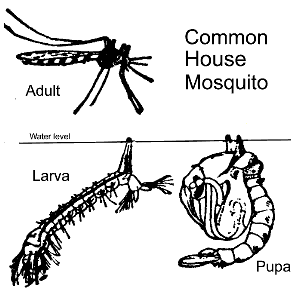
In 1937 in the West Nile district of Uganda a new virus was discovered. Since then, there have been outbreaks in Egypt, Israel, South Africa, and in parts of Europe, Asia and in 1999 it arrived in North America. In Africa and the Middle East where it originated many species, notably birds, have developed immunity. When it arrived in North America large numbers of dead crows and jays showed that birds on this continent lack resistance to this new virus. Since its arrival, the virus has spread rapidly across much of the United States and Canada and is expected to continue to spread further, potentially affecting increasing numbers and species of birds, mammals, and possibly other species.
While it is spread by several species of mosquito, the common house mosquito (Culex pipiens) is considered to be the most significant West Nile Virus carrier in North America. This mosquito prefers to breed in small pools of stagnant, dirty water typically found close to households and neighbourhoods. It is most active from dusk to dawn, and takes cover under grass and brush during the day. It is a relatively weak flyer, and is not believed to travel very far from the larval habitat. A generation varies from about one to two or more weeks, depending on weather conditions.

People can get West Nile virus if they are bitten by an infected mosquito. While, its important to remember that the risks of being bitten by an infected mosquito are low and the chances of becoming seriously ill are even lower, people who are exposed to mosquitoes where West Nile virus exists could become infected. Unfortunately a few of those infected will become seriously ill or even die.
People are encouraged to reduce the risk of infection by minimizing the chance of being bitten; wear long-sleeved light coloured clothing, use insect repellents, avoid spending time outdoors between dusk and dawn, when mosquitoes are most active.
At the same time eliminate mosquito breeding sites near your home by cleaning eavestroughs, rinsing bird baths and pool covers, and seeing that old tyres, cans and other things that can hold water are not lying around. Mosquitoes lay eggs in standing water and it takes about four days for the eggs to grow into adults that are ready to fly. Even a small amount of water, for example, in a saucer under a flower pot, is enough to act as a breeding ground. As a result, it is important to eliminate as much standing water around your property as possible.
Biological controls should be left to public health authorities. Natural wetland habitats which are home to a diversity of life should not be poisoned. Human-created places are very different from native wetlands, which are tremendously rich and important natural areas. Natural wetland habitats serve vital ecological functions, and are home to a diversity of wildlife and insect species, including an abundance of natural predators of mosquitoes.
Attempts to eradicate mosquitoes by spraying pesticides are likely to be ineffective at best, and at worst, harmful to human and ecological health. There is a possibility of causing more long-term harm than good. It should only be used as a last resort.
For more information see these websites:
